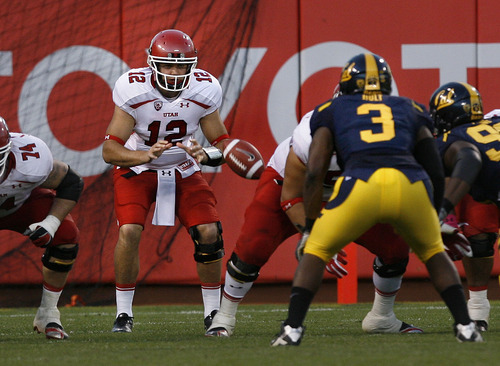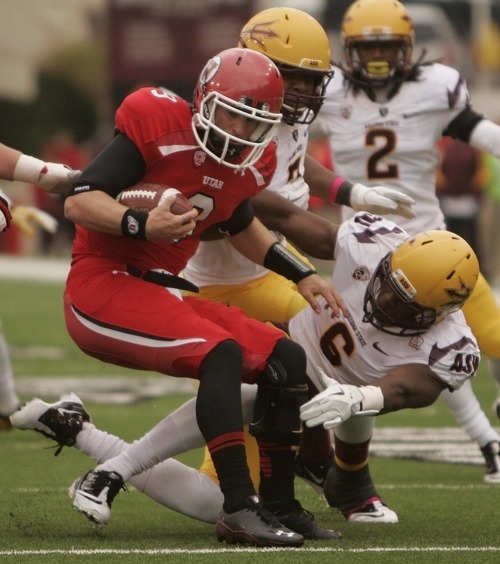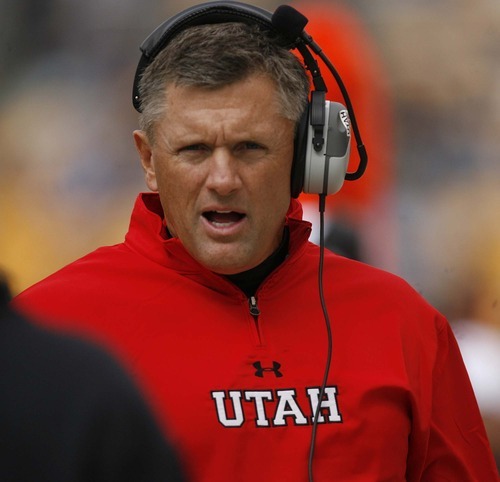This is an archived article that was published on sltrib.com in 2011, and information in the article may be outdated. It is provided only for personal research purposes and may not be reprinted.
The Utah Utes are sticking with Jon Hays as their quarterback. Not because the transfer from Butte College won a fierce battle for the position or because he came in and dazzled everyone with his throwing ability. The Utes are staying with him because they have no other realistic option.
Tyler Shreve, the freshman out of Highland Calif., simply can't handle the job right now and is being redshirted. Griff Robles, a sophomore who was converted to linebacker this year, is Hays' backup. But he isn't a long-term solution because the Utes are planning to move him back to defense next season.
The next guy? Well, there really isn't one, unless you want to count walk-on Adam Schulz, a freshman the Utes know so little about that the school still doesn't even have a bio on him.
Which leads to this question: How did the Utes, a team that has spent the past two years preparing for a move to the Pac-12, get caught so short-handed in the highest profile position that exists?
Credit a mix of bad luck, position changes and possibly even some bad recruiting decisions.
Utah coach Kyle Whittingham likened the current position to 2004 and 2005 when all the Utes had were Alex Smith and Brian Johnson. However, there is no arguing those were quarterbacks of a different talent level than the Utes have now.
"It's a position you don't want to get caught short-handed at," Whittingham said. "But right now we are doing the best we can under the circumstances we are under. We have to continue to recruit that position and the future looks bright next year and hopefully we can weather the storm."
The Utes knew finding a quarterback was going to be a priority for the 2009 season to replace Brian Johnson, who led the Utes to an undefeated 2008 season and left school with more wins than any quarterback in Utah history.
Waiting for the chance to replace Johnson was Terrance Cain, a junior transfer from Blinn Community College, Jordan Wynn, a freshman from Oceanside, Calif., junior Corbin Louks — a dual-threat quarterback who was the only one with game experience for the Utes — and Griff Robles, a former Spanish Fork quarterback who was one of the top recruits in Utah.
The Utes believed this group left them set for the future, enough that they stopped recruiting Keith Price, a quarterback out of Compton, Calif., who ended up at Washington instead and is developing into one of the best quarterbacks in the Pac-12, if not the nation.
DeVonte Christopher, the 2007 Nevada Gatorade Player of the Year as a quarterback, was moved to receiver.
The quarterback battle was decided enough in the preseason camp that Louks, who went into camp listed as No. 1, transferred to Nevada after he slipped to No. 3 behind Cain and Wynn. In retrospect, the decision to drop Price and the failure to keep Louks in a Utah uniform might have been the biggest developments that led to the Utes' current quarterback dilemma.
The coaching staff believed that by recruiting at least one quarterback per class, they would have plenty of talent at that position.
However, no one could have predicted Wynn would be so injury-prone, or that Shreve's entry into the school would be delayed a year following a skirmish with his high school baseball coach that led to his temporary banishment from the program.
Perhaps, with another year behind him, Shreve would be quarterbacking the Utes now instead of Hays. As it is, Utah offensive coordinator Norm Chow says Shreve is talented, but still has to grow as a quarterback.
"He is a really good athlete, but in this league you can't just be a good athlete," Chow said. "You have to be smart, you can't just have the abilities and it takes time to develop."
Utah's other quarterback option, Brian Blechen, was rated as the No. 14 dual-threat quarterback in the nation as a high school senior out of Moorpark, Calif. But he was moved to defense upon his arrival in 2010.
Whittingham said the Utes' philosophy of recruiting all-around good athletes lends itself to switching players from the quarterback position when they arrive at Utah because often those players were simply the best athletes on their high school team — but perhaps not top quarterback material. But that has left the Ute coaching staff open to criticism that it may have sacrificed legitimate QB candidates for gains at other positions.
Whittingham disagrees.
"I don't think we have robbed the position of viable candidates for a big-time quarterback," he said. "I could be wrong with that, but usually we are going after guys who are simply the best athletes on the team."
The Utes' big recruiting miss came last year, when they failed to sign high school quarterback and highly prized prospect Michael Eubank, who went to Arizona State, and one-time Utah commit Derrick Brown, who landed at Washington.
Their decisions are hurting the Utes now, according to Scout.com's Brandon Huffman.
"I think the depth is really hurting Utah because both Derrick Brown and Michael Eubank had the ability to get into the mix and potentially start this year, not unlike Jordan Wynn did in 2009," he said.
Both Brown and Eubank are redshirting at Washington and Arizona State respectively.
Following spring practice in which Robles and Shreve took most of the snaps — Wynn was recovering from shoulder surgery — Chow set out to find a junior college quarterback knowing the Utes needed someone with experience.
"You want to have four, but you have to count on at least two or three quarterbacks," he said. "It's a tough league."
That search turned up Hays, who was available because Nebraska-Omaha dropped its football program. Now Hays is the man while Wynn recovers from his second shoulder surgery and Shreve develops. Robles is ticketed to return to the defense after the season.
"Jon is our quarterback," Whittingham said. "He does give us the best chance to win."
Despite the lack of depth behind Hays, the Utes say they don't believe they need to rush out and sign more quarterbacks next year.
Wynn and Hays should both return and perhaps by then Shreve will be ready. The Utes also have two quarterbacks who have committed — Lone Peak senior Chase Hansen and Travis Wilson, a highly touted recruit out of San Clemente, Calif.
Although Whittingham can't comment directly on recruits, he said Monday he felt the Utes are in good shape for the future.
"With two coming in, that would give us four or five in the program and that should put us right where we need to be, where we hope to be," he said.
Even if, right now, the Utes are far from where they want to be.
Utah's quarterback Where are they now?
Since Brian Johnson's reign ended in 2008, the Utes' quarterback position has been in a state of flux. Here is a look at the quarterbacks and former quarterbacks who have come and gone since, including their current status:
Corbin Louks • Listed as the top quarterback going into 2009, Louks transferred to Nevada when he slipped down the quarterback depth chart and the Utes tried to make him a safety. Now a senior receiver at Nevada.
Griff Robles • Moved from quarterback to linebacker after last spring. Now the No. 2 QB after being moved back this fall.
DeVonte Christopher • The 2007 Nevada Gatorade Player of the Year was switched to receiver in 2009 after redshirting in 2008.
Jordan Wynn • Beat out Terrance Cain for the starting role as a freshman in 2009 and finished the year as the Poinsettia Bowl MVP. Out for the rest of the season with a shoulder injury.
Brian Blechen • Rated the No. 14 dual quarterback in the country by Rivals as a 2009 high school senior. Was converted into a safety as a freshman.
Tyler Shreve • Signed with Utah in 2010 but didn't enroll until the '11 spring semester. Redshirting.
Jon Hays • Joined the Utes in the summer from Butte College after Nebraska-Omaha dropped its program. Current starter.
Adam Schulz • Freshman out of Muskego, Wis., walked onto the team. Now the No. 3 QB —
Oregon State at Utah
Saturday, 5 p.m.
TV • Ch. 14











